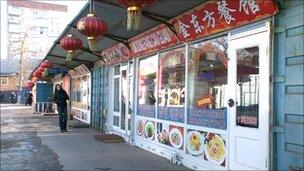Russia's Far East turns towards Asia again
- Published

You do not see many Asian faces on the streets of Vladivostok
The icebreakers have been busy keeping Vladivostok's Pacific port open for business this January.
A particularly cold spell of weather has covered large parts of the famous harbour with ice, and there are not many ships coming in and out.
The cranes in the port are standing completely idle.
Since Russia began to emerge from the economic crisis that has become a rare sight - the volume of goods coming in from China has increased by 40% over the past year.
Trade with the booming neighbour already dominates business at the port, rivalled only by Korea.
Economic driver
Many of the ships in the port carry the logo of Fesco.
Today Russia's largest private transport company, Fesco started life 130 years ago as a shipping company connecting the newly built port city of Vladivostok with the European part of Russia and with Asia.
For Vladimir Korchanov, Fesco's managing director, it is clear that the future for his company again lies in the East.
"China is the main driver of the world economy, and that will last for the next 10 or 15 years at least," he says.
Fesco is opening new offices and plans to increase capacity on its shipping lines in the region.
Investment needs
Russia's ports in its Far East are the main export route for commodities from Siberia such as coal, oil and timber.
The border with China is nearly 3,600 km long, but there are only two points where it is possible to cross it by road or rail.
A lot of investment is needed to build the infrastructure that Russia needs to increase its exports of commodities to Asia.
The first oil pipeline between the two countries only started pumping oil at the beginning of the year, and was financed with a $25bn (£16bn) loan from China.
Renewed interest
Resources-rich Russia and cash-rich Asia would appear to be a perfect match. But when it comes to private investment, things are a little more difficult.
Presenter Tanya Beckett introduces the next programme.
In the nearly 20 years since Vladivostok re-opened to foreigners, many investors from South Korea, Japan and China have come - and left again.
In the Korean restaurant in the city's Hyundai Hotel, one of the longer lasting examples of foreign direct investment from Asia, I meet up with Natalia Prisekina from the law firm Russin & Vecchi, who advises mainly Asian clients.
She says interest in Russia's Far East has recently picked up again, especially from Korean and Japanese companies.
Many of them want a slice of the construction boom triggered by massive state investment in infrastructure ahead of the 2012 Apec summit in Vladivostok, she says.
"The Koreans like to make fast decisions, the Japanese take much longer", she says while her bibimbap, a traditional rice-vegetable-meat dish, cooks in a hot stone pot in front of her.
But most of her clients have the same concerns: "They think that legislation in Russia is not transparent, that the government may change laws to the disadvantage of foreign investors."
Reality bites
It is a view shared by many Chinese companies.
"There is great interest from Chinese business in Russia, and they definitely have the necessary financial means to invest here", says Xue Huilin, who edits a monthly newspaper about Chinese-Russian relations.
"The problem in Russia is that the law is one thing - but when a company starts working here it faces the reality - the bureaucracy and different rules - and it becomes almost impossible for them to overcome these barriers.
"As a result there is a succession of unsuccessful examples that frightens others. And by now that's well-known throughout China," he says.
Limited access
A lot has changed in the city in the 18 years since Xue Huilin left China and settled in Vladivostok.
When he came, he was one of thousands, labourers and traders mostly, who sold their wares in makeshift markets.
But in recent years, Russia has limited access to the labour market and restricted Chinese trading.
Xue Huilin, now a Russian citizen, estimates that today there are only about 10,000 Chinese living in the Far East region.
"Living here is not easy for them," he says.
"Most are poor villagers, with little formal education. They live in small apartments, many people in one room", he says.
There have been reports of immigrants having their passports taken away by corrupt policemen.
Full circle
For a city that is so close to Korea, Japan and China, Vladivostok certainly has a surprisingly strong European feel about it.
You do not see many Asian faces on the streets. The city's Chinatown is a far cry from that in that other famous hilly port city on the Pacific, San Francisco.
Here it is really just a few cheap Chinese restaurants and a few stalls.
"I like it here, but I'll only stay a few years, then I'll go back", says a young Chinese woman who works in one of the restaurants.
Many of her compatriots seem to feel that way - contradicting fears among some in Russia that China with its huge population might seek to "take back" the Far East.
Lately, the region has eased restrictions in some areas, allowing in construction workers from abroad to fight a labour shortage in the construction sector. Many of them come from North Korea.
In a sense history has come full circle: it was mostly Chinese and Korean workers who helped build the city in the mid-19th century after Russia had acquired the territory from China.
Now they are building the hotels, roads and bridges that are being erected in the run-up to the Apec summit - a high profile event that the government hopes will help bring more foreign investment to this long neglected part of the country.